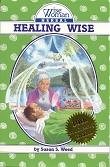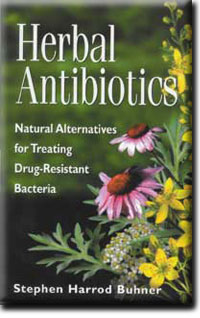Herbal Adventures with Susun S Weed
Susun Weed in Provence part 2
© 2002 Susun S. Weed
as seen printed in www.sagewoman.com
I've never felt a hotter sun than the one that blazed in the blue skies of Provence that June as I road mountain trails on my sturdy mountain horse.  To shelter from that searing sun -- alas my hat had blown off on a wild gallop that caught me unwares on the very first day -- I took to riding under trees. And what trees there were to duck beneath: tasty cherry trees loaded with fruit, wise olive trees shimmering in the sunlight, mysterious many-storied elders covered in lacy flowers, the humming lindens, and acre after acre of an amazing shrub called genet. Each tree more appealing, more fragrant, more enticing than the next.
To shelter from that searing sun -- alas my hat had blown off on a wild gallop that caught me unwares on the very first day -- I took to riding under trees. And what trees there were to duck beneath: tasty cherry trees loaded with fruit, wise olive trees shimmering in the sunlight, mysterious many-storied elders covered in lacy flowers, the humming lindens, and acre after acre of an amazing shrub called genet. Each tree more appealing, more fragrant, more enticing than the next.
When our trail took us through villages, I road along the side of our group, for the streets were lined in blooming linden trees. Have you ever smelled a linden tree in bloom? The scent of the golden flowers, dangling in clusters, intoxicates humans and bees. Wild food writer Euell Gibbons called it "the tree you find by listening." When in bloom it literally buzzes! Even though they were all around me, I didn't fear the bees. I knew they were drunk on linden nectar. And my teacher Juliette de Bairacli Levy insists that bees will not harm those who don't harm them. It works with wasps at home, and it worked with the bees in the linden trees in Provence too, I'm happy to say.
When we stopped at the public water trough to let the horses drink, I gathered some of the blossoms by pinching them off just above the strap-shaped, leaf-green samara that they hang from. Millions of women for generation after generation have done the same. The tea of these flowers is soothing to all the mucus surfaces. Well-liked by children, it is tasty cold and marvelous hot with honey (thank you bees).
I could also say I was harvesting lime blossoms. Confusingly enough, that is another name for linden. She is also loving called, in many languages, tillia, which is her botanical name as well: Tillia americana, Tillia europa. And to many she is basswood, whose bark is unsurpassed for fiber and cordage.
That night, when we stopped, I harvested more linden. It is one of my favorite winter infusions. Though conditions were less than perfect for drying, as I had to pack up and move every day, lime blossoms are sturdy and they dried well enough to make the smile-inducing cup of infusion I am drinking as I write this. The smell and taste transport me to the evenings I sat watching the sun set across the ranges of the Luberon sipping a tea of the fresh flowers --minus bees. I love the thick, silky, texture and slightly sweet taste of linden. She soothes my throat and lungs and helps me sleep better, too.
At the outskirts of the villages the elder bushes would begin. At home, in the Catskills, winter frosts kill the elders back and they rarely grow more than twelve feet high. But these elders were so tall, with such barky, thick trunks, they truly were trees: one overtopped a three- story barn. Most of course were smaller, lower, and wider, colonizing abandoned monestaries as well as road edges. Like fairy limbs reaching out to caress me, their boughs swayed with lacey doilies of nectar-sweet medicinal elder flowers.
 I knew better then to grab a handful of elder blossoms for my tea, the way I had been grabbing a cherry here and there on the way, or harvesting linden flowers from the vantage of horseback. Everywhere the elder (Sambucus) grows, the folk tell tales of her powers, say she is a witch, a wise woman, a baba with great curative powers, but a very short temper. If you honor elda mor, the spirit of the elder, you may harvest and use her many parts; and you will be reknowned for your cures. If you dishonor her, she will have revenge; she will sicken you, turn your cures to poisons.
I knew better then to grab a handful of elder blossoms for my tea, the way I had been grabbing a cherry here and there on the way, or harvesting linden flowers from the vantage of horseback. Everywhere the elder (Sambucus) grows, the folk tell tales of her powers, say she is a witch, a wise woman, a baba with great curative powers, but a very short temper. If you honor elda mor, the spirit of the elder, you may harvest and use her many parts; and you will be reknowned for your cures. If you dishonor her, she will have revenge; she will sicken you, turn your cures to poisons.
Elder is known to be an amazing immune system tonic. Half a glass of elder berry wine when you feel a cold or flu coming on is far more effective than taking echinacea. If you don't have enough berries to make wine, you could use: elder flower champagne, elder berry jelly, elder flower pancakes, elder berry vinegar, elder flowers in honey, elder bark tincture, elder berry honey, elder flower tea, elder berry tincture, elder flower tincture, elder root tincture (You must be in very, very good communication with elder before you dare to touch her root.)
This is my favorite recipe for Elder Flower Champagne. It is popular in New Zealand, where I first tasted it. It is so delicious, so easy to make, and ready so soon, that it is sure to become one of your summer rituals. (And a great way to remember summer at winter solstice!)
7 large heads of elder blossoms
1 pound of white sugar, no substitutes!!
2 large or 3 small organic lemons
2 tablespoons apple cider vinegar
1 gallon water
4 liter-sized wine or champagne bottles and corks
Dissolve sugar in 1 quart of boiling water. Add rest of water. Slice lemons very thinly and add to water/sugar. Add vinegar and mix well. Place elder flowers head down in a crock, large glass bowl, or non-metal pot. Pour liquid mixture over flower heads. Cover with a kitchen towel held in place with a rubber band. After 24 hours, strain through a fine cloth (I use a clean cotton diaper), bottle, and cork. Mature your Elder Flower Champagne in the dark for three or more weeks. It will be naturally fizzy when ready to drink, so watch out when you pop the cork!
I wished for some fizzy elder brew in that hot sun, but even as I called the taste to mind, and the happy smiles of the apprentices as they make it, we left the village by-ways behind and began to follow faint, and densely-wooded tracks, climbing up out of the valley and back into the mountains, where I was to meet a plant that took my breath away.
Green Blessings.
Susun Weed








